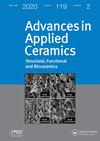Prediction of stress–strain response of unidirectional ceramic matrix composites under arbitrary loading and unloading
IF 1.6
4区 材料科学
Q3 MATERIALS SCIENCE, CERAMICS
引用次数: 0
Abstract
ABSTRACT The constitutive response of ceramics matrix composites (CMCs) under arbitrary loading and loading was studied. A method for determining the distribution of slip regions under arbitrary loading was proposed based on the shear lag model and slip law. Furthermore, a method for judging the closure of the matrix cracks was given based on the assumption that the fibre strain consists of the elastic strain and the pseudo-plastic strain of CMCsss. The stress–strain response of CMCs was obtained in form of matrices based on the distribution of the slip regions instead of the integration of fibre stress in each slip region. The simulated results show that the proposed method improves the computing efficiency greatly compared with previous approaches. Additionally, the simulated results agree well with experimental data, proving that the method proposed in this paper is credible.单向陶瓷基复合材料在任意加载和卸载下的应力应变响应预测
研究了陶瓷基复合材料在任意载荷和载荷作用下的本构响应。提出了一种基于剪力滞模型和滑移规律确定任意荷载作用下滑移区域分布的方法。在假定纤维应变由CMCsss的弹性应变和拟塑性应变组成的基础上,提出了一种判断基体裂纹闭合的方法。cmc的应力应变响应采用基于滑移区分布的矩阵形式,而不是基于每个滑移区的纤维应力积分。仿真结果表明,该方法与现有方法相比,计算效率有较大提高。仿真结果与实验数据吻合较好,证明了本文方法的可靠性。
本文章由计算机程序翻译,如有差异,请以英文原文为准。
求助全文
约1分钟内获得全文
求助全文
来源期刊

Advances in Applied Ceramics
工程技术-材料科学:硅酸盐
CiteScore
4.40
自引率
4.50%
发文量
17
审稿时长
5.2 months
期刊介绍:
Advances in Applied Ceramics: Structural, Functional and Bioceramics provides international coverage of high-quality research on functional ceramics, engineering ceramics and bioceramics.
 求助内容:
求助内容: 应助结果提醒方式:
应助结果提醒方式:


